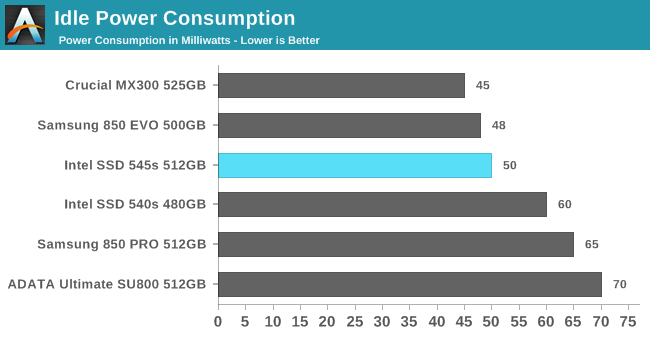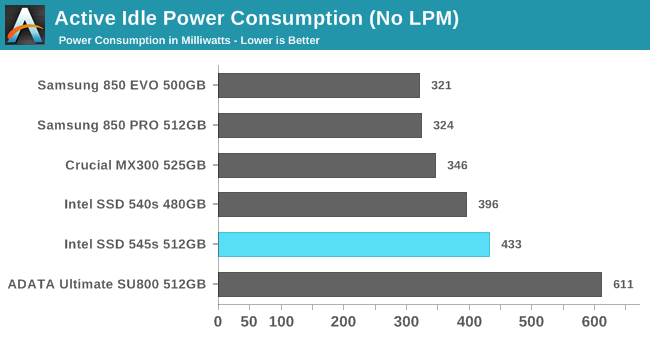The Intel SSD 545s (512GB) Review: 64-Layer 3D TLC NAND Hits Retail
by Billy Tallis on June 27, 2017 6:00 AM ESTIdle Power Consumption
Since the ATSB tests based on real-world usage cut idle times short to 25ms, their power consumption scores paint an inaccurate picture of the relative suitability of drives for mobile use. During real-world client use, a solid state drive will spend far more time idle than actively processing commands. Our SYSmark 2014 SE test covers this case, but because our testbed is a desktop system the SSD's contribution to the total power usage is small and hard to isolate from ordinary variation between test runs.
Our testbed doesn't support the deepest DevSlp power saving mode that SATA drives can implement, but we can measure the power usage in the intermediate slumber state where both the host and device ends of the SATA link enter a low-power state and the drive is free to engage its internal power savings measures.
We also report the drive's idle power consumption while the SATA link is active and not in any power saving state. Drives are required to be able to wake from the slumber state in under 10 milliseconds, but that still leaves plenty of room for them to add latency to a burst of I/O. Because of this, many desktops default to either not using SATA Aggressive Link Power Management (ALPM) at all or to only enable it partially without making use of the device-initiated power management (DIPM) capability. Additionally, SATA Hot-Swap is incompatible with the use of DIPM, so our SSD testbed usually has DIPM turned off during performance testing.

With SATA device-initiated link power management enabled, typical idle power consumption drops by a factor of ten, straining the resolution of our power meter. All of these SATA SSDs have very effective low-power idle states, but the 545s does show clear improvement over the 540s and Intel is now quite close to the Crucial MX300 and Samsung 850 EVO.

The Samsung drives have the best active idle power levels of this bunch, and the Crucial MX300 is not far behind. The Silicon Motion-based Intel 540s, 545s and ADATA SU800 are worst, though only the SU800 is trailing by a large margin. The 545s does draw more power than the 540s, which is not what we would expect from an updated controller design.
Idle Wake-Up Latency
Idle power consumption is not the only important metric of a SSD's power management capabilities. Devices cannot transition in and out of low-power states instantly. It takes time for components to switch back to higher clock speeds and resynchronize their data links to the rest of the system. At the extreme end, the several seconds it takes a hard drive to spin up obviously has a major impact on system responsiveness, and consequently operating systems have to be very conservative about when to put a hard drive to sleep, typically requiring at least several minutes of idle time during which the hard drive is wasting power.
The idle power transition time of solid state drives exists on a very different time scale, but it still matters to systems that are trying to minimize power consumption without sacrificing too much performance. When a SSD only takes a few milliseconds to enter and leave a power saving state, those power saving states can be used far more often, even during sustained interactive use like gaming. The cost of this approach is that far more I/O operations will incur the wake-up latency penalty.
Our equipment is not able to measure how long it takes a SSD to enter a low-power state; this would require very precise synchronization between the CPU and a high-resolution power meter. Timing how long a SSD takes to leave a low-power state is simple: perform one read operation every few seconds, and compare the latency with and without power management enabled. The difference, reported below, includes time taken to reestablish the SATA link and for the SSD to wake up, but does not include the time spent actively reading data from the flash memory since that will be the same whether or not the SSD had just been in a low-power state. Thus, this test is mostly a measure of the SSD controller and its firmware.

The Crucial MX300 has pretty good power consumption both at idle and under load, but its Marvell controller takes far longer to wake up from idle than its competition. At about 3.4ms, the MX300 is almost five times slower to wake up than the ADATA SU800, which has higher idle power consumption. The Intel 545s is a bit on the slow side at 1.4ms, about twice the wake-up latency of the ADATA SU800 or the Intel 540s. The total read latency for the 545s with power management enabled is just over 2.2ms.










74 Comments
View All Comments
ddriver - Tuesday, June 27, 2017 - link
Actually yes. Way to go intel...anactoraaron - Tuesday, June 27, 2017 - link
What's wrong with the 600p? You can get the 512gb from newegg for $179, which make me question the 545s price point. If you aren't limited to sata, the 600p 512gb makes much more sense.ddriver - Tuesday, June 27, 2017 - link
"What's wrong with the 600p? "Nothing, aside from the fact it is THE lousiest NVME SSD in the known universe...
Drumsticks - Tuesday, June 27, 2017 - link
Good thing it generally sells at SATA prices then...junky77 - Wednesday, June 28, 2017 - link
It's really not even as fast as SATA SSDs in many tests (I'm talking midrange SSDs, nothing fancy)kaidenshi - Wednesday, June 28, 2017 - link
I've seen a ton of hate for the 600p here, and I can only conclude that I got extremely lucky with mine and ended up with a fluke. Mine has been hands down the fastest SSD I've ever had, and even paired with a bargain-basement Pentium G4500 CPU, it makes everything on my PC feel instant.Perhaps it is the slowest NVMe SSD one can buy, but it is much, much faster than any SATA SSD I've had in this machine. It definitely blows the doors off the 850 Evo, despite claims I've seen here that it's slower. The results on this site mirror what I've seen in my own testing. Basically, the Samsung beats the Intel on random reads only, but loses spectacularly on all other metrics.
http://ssd.userbenchmark.com/Compare/Samsung-850-E...
Samus - Thursday, June 29, 2017 - link
It isn't a speed demon, but it isn't slow either. It's just what you'd expect for the price.And it's sequential transfer rates are substantially faster than anything SATA, so that is the icing on the cake for an SSD that sells for SATA prices.
And being Intel, I expect it will be ultimately more reliable than a similar priced product form ADATA, etc.
alpha754293 - Thursday, June 29, 2017 - link
What's wrong with the Intel 750 series PCIe NVMe SSDs?futrtrubl - Tuesday, June 27, 2017 - link
I'm going to assume the sustained sequential write speed of 40MB/s is a typo.futrtrubl - Tuesday, June 27, 2017 - link
Oh wow, I see it is not.